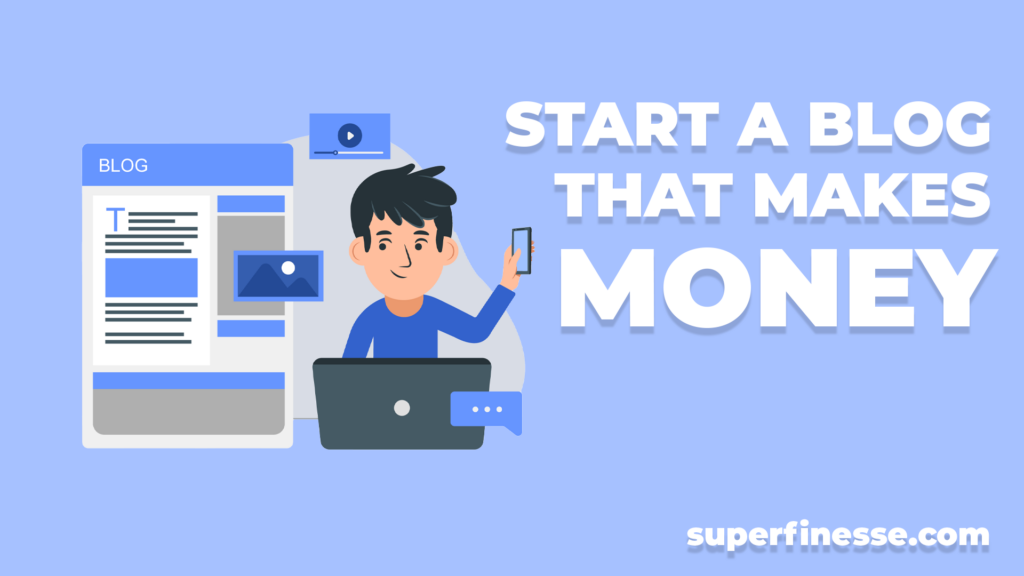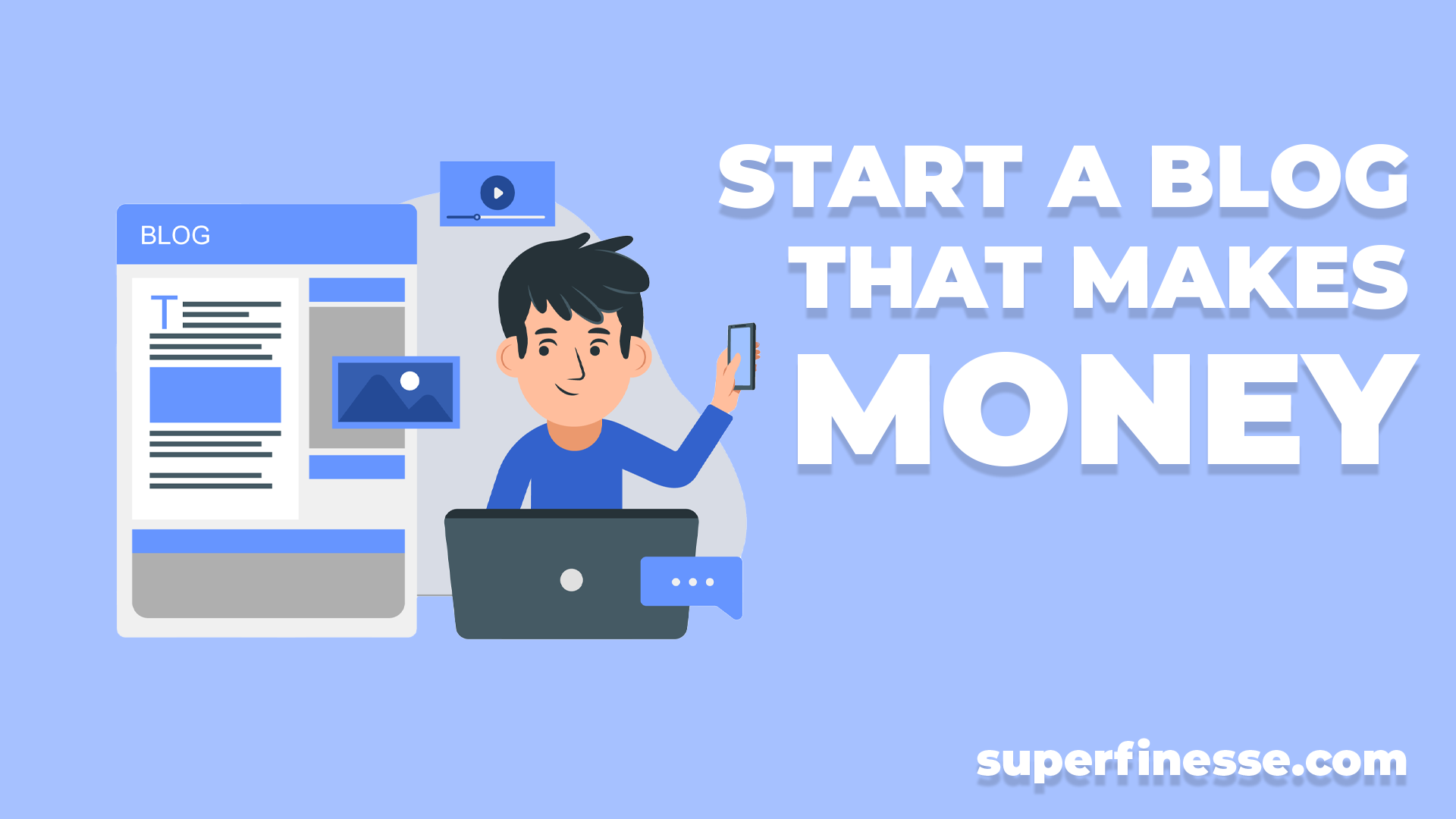Let’s make this super clear!
It’s never going to be too late to start a blog! Blogging will not die!
Blogging will constantly evolve and we will adapt every step of the way to stay on top!
Now, let’s begin our journey on how to build a blog from scratch that makes money! I will show you the techniques I have used to help my clients build a successful blog to accomplish their goals.
Table of Contents
Start a Blog: 8 Steps to Start a Profitable Blog (Only Guide You’ll Need!)

- Establish and Set Your Goal
- Choose your Niche and Audience
- Set up Domain and Web Hosting
- Setup and Build Your Blog
- Create Helpful Content
- Grow your traffic
- Monetize Your Blog
- Maintain & Nurture
Disclosure: Please keep in mind some of the links are affiliates in this article which helps me keep everything I teach on my website and YouTube channel completely free. If you click the link and buy something, I will earn a small commission.
I will teach you everything I have learned over the years so you have a shorter learning curve to reach your goal.
Let’s begin!
1. Establish and Set Your Blogging Goal
I have made this the first step for a very good reason!
If you skip this, then it’s very difficult to follow the process of getting anywhere! So, make sure you know why you are doing what you are doing.
Your goal can be as simple as “Make money with my blog” or “Monetize my YouTube Audience” or even to start a blog as a side income source.
What are some example goals for blogging?
It could be:
– Hobby Blogging
– Passive Income
– Extentsion of your brand
– Full-time Income
– Build a community
Why is a blogging goal important?
When you have established and defined your goal to blog, you can structure a proper plan of how to grow the blog and sustain it for the longer run. So, it’s key to have a proper blogging goal.
My example for this blog that you’re reading is, I wrote it down as “I want this blog to be an extenstion of my YouTube channel“
Now, take your time and really think about why you are sarting the blog and what is your end goal with it.
When you are done, I would suggest you to write it on a paper or on your notes on your phone. By doing this when you are going through your ups and down, you can refer back to why you started.
You got this!
2. Choose your Niche and Audience
Choosing the niche you want to blog in and establishing the targeted audience is a step that once you have properly defined, it’s very easy to know where you should be putting your most time.
Your niche can be anything that you’re interested in and also don’t mind exploring more on.
Because you need to pick something that you can stick to for the long run. It can’t be something that you have no interest in.
When you take up something that you’re passionate about, it will be much more fun for you to enjoy the process rather than finding it stressful.
Also, when you pick your niche you can easily know what audience might find that interesting and helpful.
Let me answer some of the common questions that may help you with this process.
What are some profitable Niche to start a blog on?
Below are some of the most easy-to-monotize and high-paying niche ideas!
– Finance
– Travel
– Parenting
– Technology
– Food
– Beauty
– Health & Fitness
– Personal Development
– Business
– Lifestyle
3. Choose the right Domain & Hosting
Domain and Hosting are the foundation of your blog and your business online.
Domain:
Make sure you can get a domain that is easy for your customers or readers to remember. It can’t be a very long domain with an unknown or unpopular domain extension.
Your domain is your blog’s address on the internet. Tips for selecting a great domain:
Your domain is your blog’s address online. Below are my tips for selecting a good domain name:
- Keep it short and memorable
- Make it relevant to your niche
- Avoid hyphens and numbers if possible
- Opt for a .com extension if available
Let me explain:
A good example of a rememberable domain name is “mysuperblog.com” or “myshortblog.com”
A bad example of a domain for your blog would be “thisisjohndoesblog.xyz” or “mybestever-homedecor-blog7555.xyz”
Once you have decided on your desired name, you can use one of the services I recommend on the Resources page.
Hosting
Your host is where your blog’s files will be and your audience will be able to access them through your domain name. In case you didn’t know that 😛
Below are the important factors you should take into while choosing a hosting:
- Reliability and uptime
- Customer support
- Scalability as your blog grows
- Security features
- Price and contract terms
Some hosting options I use include Hostinger, Bluehost, and Cloudways. These offer a one-click WordPress installation, making the next steps much easier for you.
4. Setup and Build Your Blog
With your domain and hosting in place, it’s time to bring your blog to life.
Here’s the next important steps:
Choose your blogging platform
WordPress is the most popular choice due to its flexibility and extensive plugin ecosystem. Other options include Wix, Squarespace, or Ghost.
I would personally suggest going with WordPress!
Install and set up your platform
If you’re using WordPress, most hosts offer a one-click installation process. Or by now you should already have this set up.
Choose a theme
Your theme doesn’t need to be crazy expensive. You can also use a free one and customize it to your liking. Just make sure it’s user-friendly and SEO-friendly.
Install required plugins
Enhance your blog’s functionality with plugins for SEO, security, caching, and social sharing.
Create Important pages
Set up pages like About, Contact, Disclaimer, and Privacy Policy.
Design your logo
You can quickly go to Canva & create a logo of your liking that suits your brand.
5. Create helpful content
Creating helpful content is super important for a blog because it makes people want to visit and come back for more.
Think of your blog like a playground. If it has fun swings and slides, kids will want to play there. In the same way, if your blog has useful information or interesting stories, people will want to read it.
Helpful content answers questions, solves problems, and entertains, making readers happy and more likely to share your blog with friends.
When your content is helpful, it builds trust with your audience.
Imagine you have a friend who always knows how to fix things; you’d go to them whenever you need help, right? Your blog can be like that friend. By providing value, you become a trusted source, and people will rely on your blog for advice and ideas. This trust helps your blog grow, attracting even more readers over time.
| Step | Description |
|---|---|
| Develop a content strategy | Plan your topics, posting frequency, and content types (e.g., how-to guides, listicles, personal stories). |
| Conduct keyword research | Identify terms your audience is searching for to guide your content creation. |
| Write compelling headlines | Craft titles that grab attention and accurately represent your content. |
| Structure your posts for readability | Use headers, short paragraphs, and bullet points to make your content easy to scan. |
| Include visuals | Incorporate images, infographics, or videos to enhance your posts. |
| Edit and proofread | Ensure your content is polished and error-free before publishing. |
| Optimize for SEO | Use your target keywords naturally, write meta descriptions, and optimize images. |
6. Grow your traffic
Let’s make your blog famous! Here’s how to tell everyone about your awesome writing:
Social Media
Tell all your friends about your blog on Facebook, Instagram, or wherever you hang out online. It’s like showing off your cool new toy to everyone at school!
Start a newsletter
Make a newsletter for your biggest fans. It’s like sending secret messages to your best friends, but about your blog!
Guest Posting
Write amazing stories for other websites too. It’s like being a guest star on your favorite TV show!
Engage in relevant forums
Go to places where people ask questions and show how smart you are. It’s like being the smartest kid in class, but on the internet!
Try New and Exciting Things
Make videos, start a podcast, or do a fun online class about your blog. It’s like turning your blog into a super fun game that everyone wants to play!
Remember, telling people about your blog is like inviting them to the most awesome party ever.
The more creative and fun you are, the more people will want to come and read your amazing stories!
7. Monetize your blog
We are about to dive into the exciting world of blog monetization! This is where your blogging will start to give returns for all the hardwork.
Affiliate Marketing
Imagine having an army of salespeople working for you 24/7, without the hefty payroll. That’s affiliate marketing in a nutshell!
By partnering with brands you love, you can earn commissions of 5-30% on every sale made through your unique links.
It’s like having a slice of every pie you recommend to your audience. Sweet deal, right?
Display Ads
Your blog is prime internet real estate, so why not let it earn its keep?
By strategically placing ads with networks like Google AdSense or Ezoic you can start to make significant amount of money on your blog.
You also don’t want to have 80% of your page as ads, so make sure to have a proper balance with this one.
Digital and Physical Products
Add eCommerce to your blog and sell products related to your content. Offer digital products like online courses and eBooks or consider selling physical merchandise.
User Subscriptions
Offer exclusive content through paid subscriptions. Ensure subscribers get value with unique, high-quality content regularly.
Pro Tip: if you are a WordPress user, plugins like MemberPress make setting up subscription features pretty easy.
Remember, turning your blog into a full-time income isn’t just a pipe dream – it’s a very real possibility with the right strategies and persistence.
Keep working and stay consistent.
8. Maintain & Nurture
First, focus on consistently creating high-quality content.
Stick to your publishing schedule and maintain high standards to keep your audience engaged.
Next, analyze your performance using tools like Google Analytics regularly.
Finally, regularly update old content to keep it relevant and improve search rankings. Starting a blog is an exciting journey filled with personal and professional rewards. By following this guide and staying committed to your goals, you’ll be on the path to blogging success. Remember, every successful blogger started just where you are now. So, why wait? Start your blog today and share your unique voice with the world!






